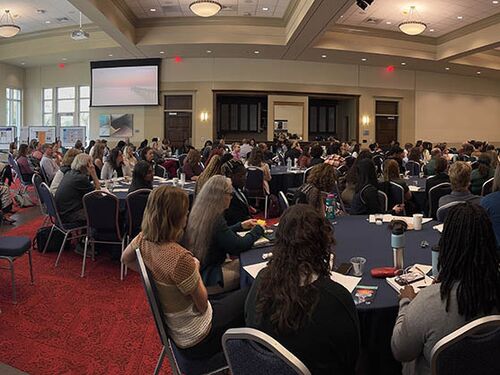Gulf Research Program Launches Initiative to Improve Sea Level Rise Predictions in the Gulf of Mexico
News Release
Last update July 21, 2022
WASHINGTON — The Gulf Research Program (GRP) of the National Academies of Sciences, Engineering, and Medicine announced $4.6 million in awards to support three project teams undertaking research to improve the forecasting of sea level rise along the Gulf Coast of the United States. The three-year initiative will focus on the oceanic component of sea level variation along the Gulf Coast.
Rising sea levels have already had impacts on many coastal ecosystems throughout the world, including in the Gulf of Mexico. Although a global phenomenon, sea level rise does not play out uniformly, and there is much geographic variation in its impacts. Many factors, including ice melt, warming temperatures, currents, winds, and even the Earth’s rotation also affect regional sea level rise. In the Gulf, land sinking due to a variety of geological factors, including fluid withdrawal, also affects sea levels.
“Many sea level rise estimates are global in scale, and this funding opportunity provides a chance to improve sea level rise predictions on a regional, Gulf-wide scale,” said Laura Windecker, program officer in the GRP’s Gulf Environmental Protection and Stewardship Board. “The Gulf is particularly in need of attention not only because of the diverse factors affecting sea level in this region but also because of the importance of understanding sea level rise for decision-making.”
A 2018 National Academies' report, Understanding the Long-Term Evolution of the Coupled Natural-Human Coastal System: The Future of the U.S. Gulf Coast, identified tracking and understanding the variations and future changes in the level of Gulf of Mexico waters as a fundamental research gap. The research funded by the GRP will improve understanding of many of the factors affecting sea level rise in the Gulf, including more local phenomena such as current dynamics and wind patterns as well as far-afield changes including the melting of glaciers.
The project teams will also develop short-term forecasts and long-term projections of sea level change in the Gulf; since warming across the globe will also affect predictions, their efforts will also incorporate the most recent projections from the Intergovernmental Panel on Climate Change.
The results of these modeling efforts will be incorporated both into user-friendly decision-making tools to support local planning efforts as well as contribute to the efforts of the Center for Operational Oceanographic Products and Services (CO-OPS) of the National Oceanic and Atmospheric Administration and the Sea Level Change Team (N-SLCT) of the National Aeronautics and Space Administration.
“Long-term environmental trends like sea level rise have important implications for environmental management,” said Michael Feldman, senior program manager in the GRP’s Gulf Environmental Protection and Stewardship Board. “By increasing scientific understanding of sea level rise in the Gulf region, this research will support greatly improved forecasting, decision-making, and local planning to benefit the region’s unique communities.”
Listed in alphabetical order by title, the projects are:
Coherent dynamic sea level changes along the Gulf Coast: Physics, seasonal predictions, and long-term projections
Award Amount: $1,124,699
Project Director: Thomas Frederikse, University of California, Los Angeles
Overview: This project focuses on better determining the various mechanisms that are driving sea level rise along the Gulf Coast. The project team will use the Estimating the Circulation and Climate of the Ocean (ECCO) framework to compute sensitivity maps to determine how sea level responds to various forcing factors, such as wind stress, heat uptake, and river discharge. The results will be used to develop seasonal predictions and long-term projections of how ocean dynamic processes will affect sea levels along the Gulf Coast.
Facilitating dynamic adaptive pathways for coastal decision-makers through land ice and water projections
Award Amount: $1,999,672
Project Director: David Rounce, Carnegie Mellon University
Overview: The aim of this project is to use a reverse sea level fingerprinting method to identify the primary contributors to sea level change in the Gulf of Mexico. Through its focus on the role of land ice and land water storage, the project results will inform related glacier and hydrological modeling efforts. Model results will be used to produce refined regional sea level rise projections that will help develop a user-focused tool to support the use of dynamic adaptive pathways in planning efforts as well as support the Louisiana Coastal Master Plan.
Improving prediction and projection of Gulf of Mexico sea level changes using eddy-resolving earth system models
Award Amount: $1,507,437
Project director: Ping Chang, Texas A&M University
Overview: The main focus of this project is to advance understanding of sea level changes in the Gulf associated with water volume variability and ocean dynamics, including changes in the Atlantic meridional overturning circulation (manifesting as the Loop Current in the Gulf). The project team will use both a high-resolution and a regional version of the Community Earth System Model to provide short-term and long-term projections of sea level change. They will also develop probabilistic sea level prediction and projection products for the entire Gulf at 3-10 km resolution, which will be integrated into the Nature Conservancy’s online Coastal Resilience Tool for local, regional, and state decision-making.
The National Academies’ Gulf Research Program is an independent, science-based program founded in 2013 as part of legal settlements with the companies involved in the 2010 Deepwater Horizon disaster. It seeks to enhance offshore energy system safety and protect human health and the environment by catalyzing advances in science, practice, and capacity to generate long-term benefits for the Gulf of Mexico region and the nation. The program has $500 million for use over 30 years to fund grants, fellowships, and other activities in the areas of research and development, education and training, and monitoring and synthesis.
The National Academies of Sciences, Engineering, and Medicine are private, nonprofit institutions that provide independent, objective analysis and advice to the nation to solve complex problems and inform public policy decisions related to science, technology, and medicine. They operate under an 1863 congressional charter to the National Academy of Sciences, signed by President Lincoln.
Contact:
Pete Nelson, Director of Communications
Gulf Research Program
PNelson@nas.edu
Featured Publication
Consensus
·2018
The U.S. Gulf Coast provides a valuable setting to study deeply connected natural and human interactions and feedbacks that have led to a complex, interconnected coastal system. The physical landscape in the region has changed significantly due to broad-scale, long-term processes such as coastal sub...
View details


